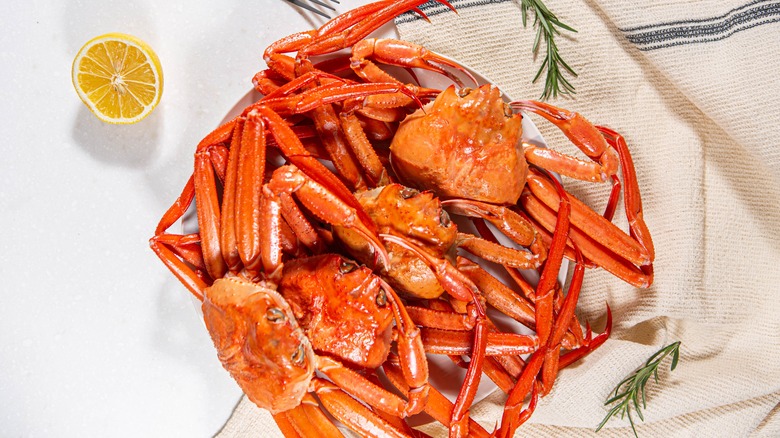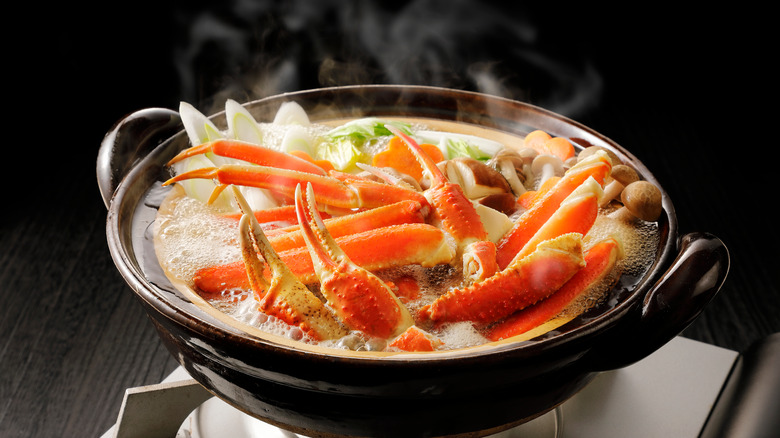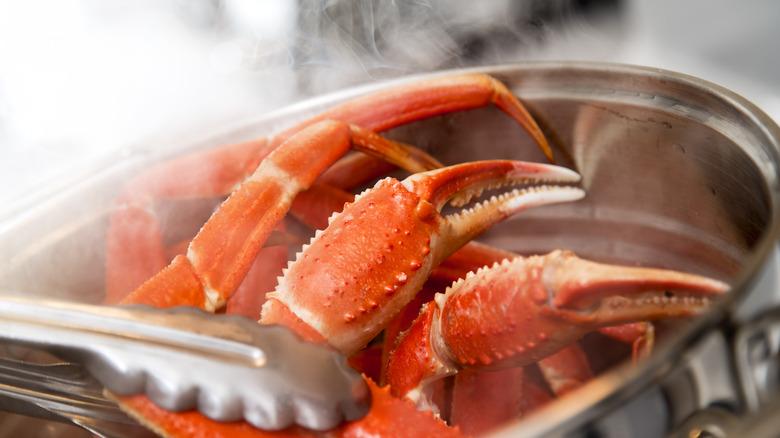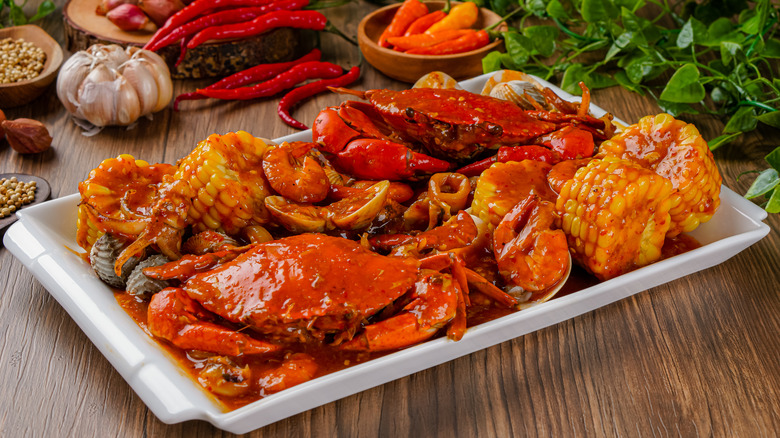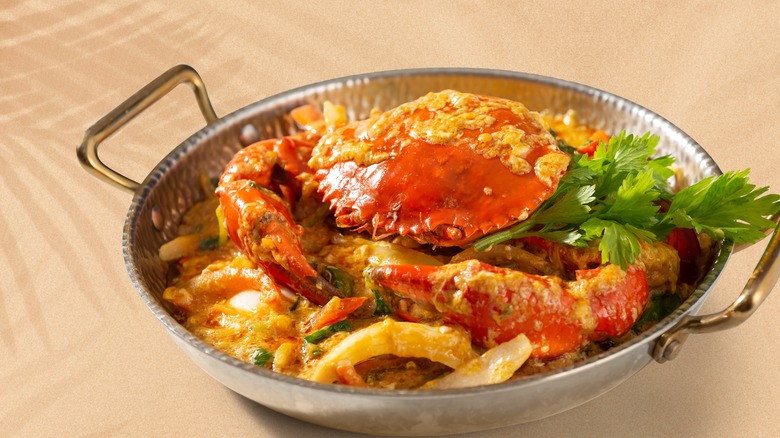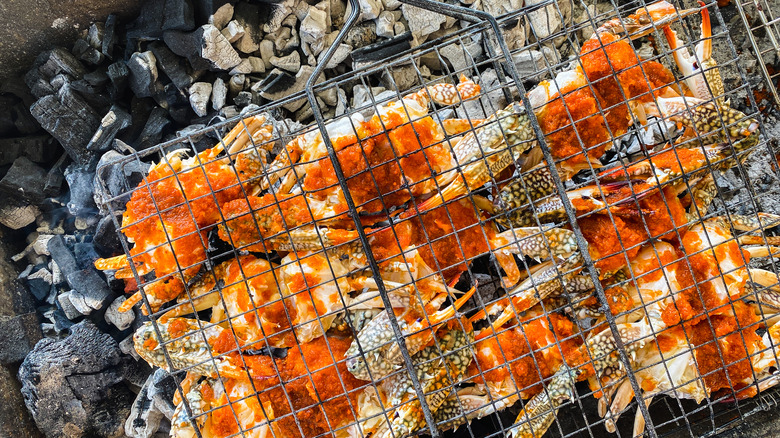The Pros And Cons Of Each Cooking Method For Crab
Take it from someone on a tiny island in the Salish Sea with boat-only access to civilization: There are a whole lot of ways to cook crab — and all of them are tasty. In the Puget Sound stretch of the sea, just off the coast of Seattle, we routinely dodge a flotilla of crab cages dotting chilly waterways, evidenced by the 1.5 million-plus Dungeness crabs pulled in every year from October through December. And that's not counting the bounty of colorful, ruby-red king crabs arriving in Northwestern harbors from Alaska's Bering Sea and Kodiak Archipelago.
Regardless of where you live, there's a high likelihood of finding seasonal fresh or year-round frozen crustaceans for fun, fine, or party-ready dining. That means plentiful pots and plates piled high with fresh crab meat, and countless ways to cook and enjoy them. From snow crabs to Dungeness, Maryland blues, Alaskan king, stone, Jonah, or Atlantic "peekytoe" rock crabs from Maine, it's surprisingly easy to create a family-and-friends feast.
It's hard to go wrong when cooking crab, but there are indeed some nuances involved. First, you'll need the freshest crab possible, preferably one that's still alive from your own endeavors or a local seafood market. But most likely, you'll be preparing one that's already been cooked and simply needs reheating. Fortunately, the same cooking methods apply either way, just with different cooking/heating times.
Boiling crabs is the go-to cooking method
Boiling crab is by far the most common method for getting a crab feast from pot to table. It's fuss-free and easy to control using a single large pot, some water, and seasoning to taste. It also preserves the natural, light, sea-fresh taste you want on your plate.
Again, freshness is crucial because of a harmful, rapidly multiplying bacteria known as vibrio that can make crab meat degrade quickly once it's no longer living. To ensure safety, make sure they reach an internal temperature of 145 degrees Fahrenheit, per the Washington State Department of Health.
Especially when cooking or reheating crab legs, boiling hot water can seep into the meat, resulting in moist tenderness. Boiling also allows easy absorption of seafood-compatible spices such as the classic "seafood boil" mix. Typical spices include coriander, bay leaves, mustard seeds, smoked paprika, allspice, garlic, red pepper flakes, dried oregano, or customized Cajun or Creole versions.
A considerable downside to boiling is the potential for textural changes. Overcooking boiled crab could rapidly turn the meat from tender to rubbery, tough, or dry. When heated, crabs release the deeply pigmented chemical astaxanthin, which turns the shell a brilliant orange or red hue; When you see that happen, it's time to remove them from the boiling water. Cooking live crabs generally takes about 12 to 15 minutes, while reheating a precooked crab requires about five minutes or even less for crab legs alone.
Steam crabs for sweet succulence
The steaming process keeps crab moist and succulent, sealing in the sweet, briny flavor of fresh-caught crustaceans. It's a more subtle process than a rolling boil, leaving a lighter, more delicate taste as well as softer meat for absorbing buttery sauces or ghee when dipping.
There's less worry about overcooking or other mistakes when cooking crab, as steam rises from underneath rather than the direct scorching heat of boiling water. It helps retain the crab's natural flavors and potentially more of its nutritional value. Steaming only takes about 10 to 15 minutes with a large stovetop pot and a steamer basket, though larger king crabs may need a bit longer. If you're only re-heating a previously cooked whole crab or a batch of crab legs, plan on a shorter process; check every three to five minutes.
One recipe for making steamed crab legs in a Dutch oven suggests jazzing up the water beneath the steaming basket. Instead of plain water, try a broth made of butter, tarragon, shallots, fresh garlic, water, and white wine. As the crab rests in a basket atop the steamy liquid, the wine-enhanced broth infuses the meat with sweet, buttery deliciousness.
A potential downside of steaming crab is that it requires a slightly more attentive approach. You'll need to keep an eye on the small amount of water in the pan's bottom to ensure it doesn't dissipate and scorch the pan, your fingers, or your precious steamed-crab dinner.
Oven-baked crabs present options
Baking crabs offers a few advantages over boiling or steaming, starting with the ability to add sauces and seasonings that won't slip away into a watery abyss. It's a mostly hands-off affair once in the oven, bypassing the constant eyeball care involved with boiling, frying, or grilling.
For live crabs, a partial boil is necessary before baking them. It only takes about five minutes in a slow boil to prep them for cooking completion in the oven. This is a good time to clean and separate them into legs, claws, and body meat. Using small pieces also provides more surface exposure for absorbing flavorings.
Placing crab pieces in an oven dish lets you slather them with butter or a creamy seafood spread such as softened butter, garlic, and fresh chopped dill. For extra zingy flavor, line the pan bottom with a few lemon or lime slices before adding the crab.
The downside of baking crabs is the extra time it takes. Prolonged oven heat can also dry out the meat. To alleviate this, Bill Nevruz of Shaw's Crab House in Chicago tells Tasting Table that home chefs could brush the crab with butter to prevent it from drying out, and then broil for a few minutes in the oven instead of baking. Alternatively, oven-based pan-steaming for five to seven minutes is as easy as placing crabs in an inch of water, adding crab, and covering with an aluminum foil dome pierced with holes for escaping steam.
Fry crabs for creative dishes
Fried crab is much less common, at least in the traditional sense. Typical batter-dipped frying has downsides with crab, most obviously that the batter sits atop a hard shell that will be removed — along with the fried batter. However, other frying methods facilitate unique crab dishes.
Sautéing or pan-frying crab is an excellent way to create flavorful, spicy seafood dishes such as Cajun crabs. Unlike simply boiling crab with Cajun seasoning, pan-frying allows for a one-pan wonder dish incorporating accompaniments such as cobbed corn and andouille sausage.
Then there's the relatively newer approach of air frying seafood. It works for fish and shrimp, but also for crabs, especially ones that have been precooked or par-boiled and broken down into legs, claws, and body meat. The process is fast and hands-off during cooking, and clean-up is easy when lining the tray with foil.
A potential negative for this kind of cooking is that the intense rotating flow of hot air could dry out the crab meat or toughen the exterior shells. Fortunately, the easy fix is also a delicious one. Choose your favorite seafood seasoning mix, such as Cajun or Old Bay, and mix it into some melted butter, olive oil, and lemon juice. Coat the crab pieces, particularly any exposed meat portions, and cradle them within an upturned bed of foil. This keeps the juices intact, tenderizing the crab meat and gently infusing it with saucy goodness.
Grilling puts a smokey twist on crab cooking
Finally, devoted grill-meisters have their own way of bringing crab to the seafood party. Cooking or heating crabs on the grill is a high-heat way to quickly cook them, with the undeniable benefit of smoky flavor and aroma. The exterior shell stands up to electric, gas, or charcoal grilling, and the high heat means quick cooking times.
Grilling is much less stressful, as the crab pieces get treated like most other meats –– lay them over heated grill grates and flip after about five minutes, for a total of 10 minutes. Thicker shells such as Alaskan king may need slightly more time on the grill, while thin-legged snow crabs should be pulled off sooner. You can also brush the legs and clusters with oil and butter to keep things tender and flavorful.
As with other methods, overcooking on the grill is a concern. Alleviating this obstacle can be as simple as wrapping the crab pieces in heavy aluminum foil and moving them away from central grill flames. A side burner of melted butter lets you crack open the crabs and dip them right in as soon as they're cooked or heated all the way through. The wide surface of a grill provides plenty of room for accompaniments such as potatoes, vegetables, sliced sausages, and compatible crustaceans such as lobster, shrimp, and crawdads.
